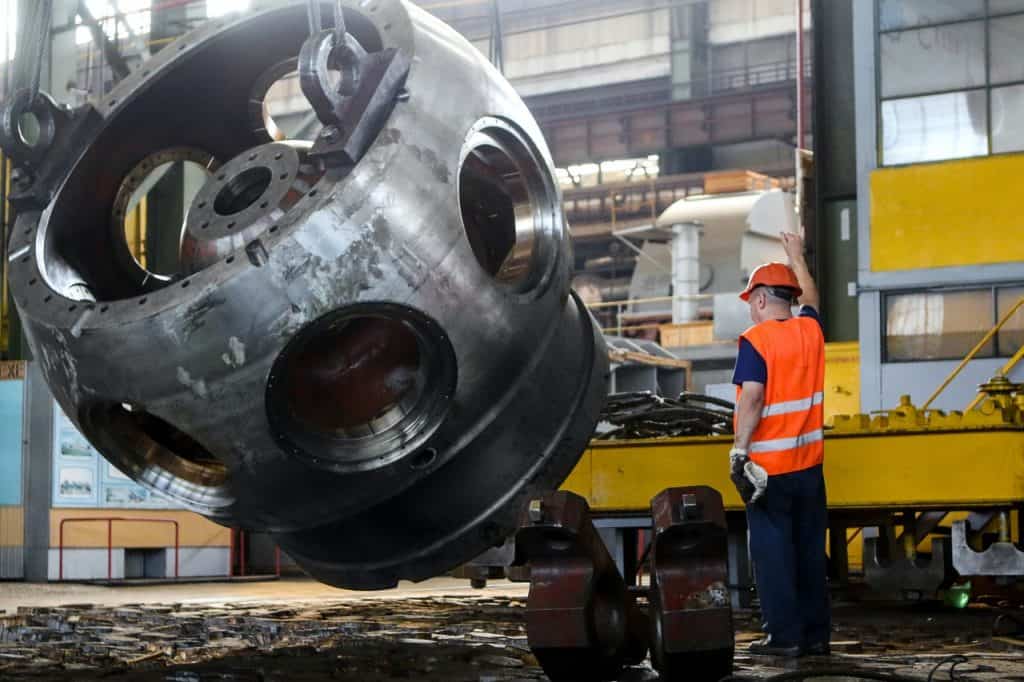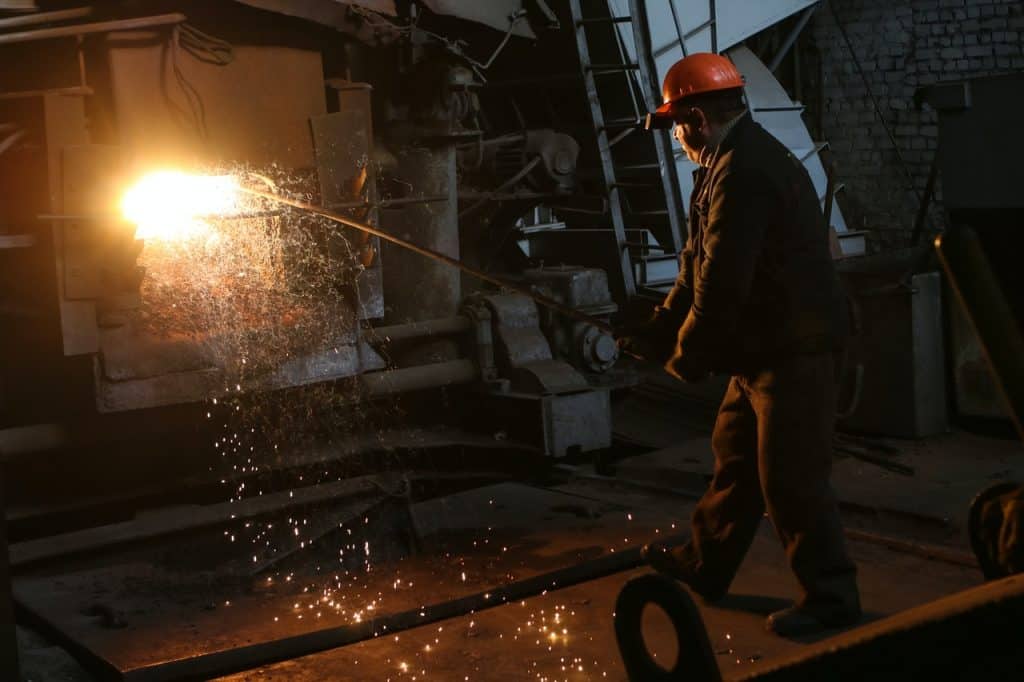A heavy metal fabrication technique involves changing the physical state of metal.
Forging refers to heating metal and then shaping it in some way, whether by rolling, pressing, or cutting.
Any engineering technique performed on metal components thinner than one inch is considered light metal fabrication.
When metals are fabricated, they are transformed into something completely different.
Heavy fabrication and light fabrication exist. The process of heavy metal fabrication involves the cutting of a thin sheet of material (often steel or aluminium) into the correct shape for subsequent use.
Sheets of raw material are bent and welded together to construct massive structures like bridges or skyscrapers in a process known as light metal fabrication.
In this article, we'll talk about the various steps involved in heavy metal manufacture, including its effects on human health, how it differs from other metals, and more.
Fabricating metal is an involved and intricate technique that not everyone is comfortable with. Metals come in a wide variety of shapes, sizes, and colours, and are used for a wide range of applications; machining methods vary depending on the metal type, with heavy metals like steel, aluminium, and titanium requiring more intensive procedures than lighter metals like brass.
The Better Question: Which Is It? What then is the distinction? Products made from heavy metal stock often involve the use of more complex machinery like lathes or mills, while those made from light metal stock can be shaped using only hand tools.
Table of Contents
Heavy Metal Fabrication vs. Light Metal Fabrication
Here at Wiley, we enjoy some heavy metal—and we don't just mean the music!
Some customers may wear Metallica or Iron Maiden t-shirts while browsing our store, but when we refer to "heavy metal," we mean it in the context of metalworking.
There's nothing we have against light metal production, but the heavier stuff just feels more... is it acceptable to say... manly?
As far as we are aware, there is no canonical definition that distinguishes between the two. It's one of those things where you just "know it when you see it." Big, hefty storage tanks and gantries for factories.
One that's made of aluminium, glass, and steel? To what extent is this "light fabrication," and where does one draw the line?
Let's investigate further to find out.
It’s In The Metal Fabrication Products
Large and weighty best describe the typical heavy fabrication. Large-scale agricultural machinery and equipment, as well as access walkways, are other good examples, along with tanks and gantries.
In fact, just about any produced structural element might be considered heavy fabrication. RV parts, brackets, toolboxes, and minor architectural elements are all examples of light fabrications.
It’s In The Metal Fabrication Materials Too
Steel and sometimes stainless steel are mentioned while discussing the necessity of strength, such as when discussing the aforementioned hefty fabrications.
Metal plates, tubes, and pipes. Now, a formal definition does exist for the plate. According to the World Iron & Steel website, ASTM A480/A480M specifies that plate steel must be at least 3/16′′ thick (5.00 mm.) The sheet can be found beneath that.
Industrial Metal Supply adds confusion by pointing out that there is a nuance with aluminium. In this context, "plate" refers to a thickness of more than 1/4 inch (6.00 mm.)
Thinner than a sheet. And while you may learn more about gauge here (Why is Sheet Metal Thickness Measured in Gauges and Not Inches?), we'd rather not. While steel and iron are commonly thought of as heavy manufacturing materials, aluminium is not.
When it comes to light fab, though, aluminium reigns supreme, both in its sheet and extruded segment forms being widely used. Copper and brass are also used in light fab, in addition to the obvious steel and stainless steel.
You wouldn't think to employ aluminium extrusion in a fabrication that relies on heavy metals, either.
And The Metal Fabrication Processes
There are special methods required to cut and shape these "heavy" structural materials, as opposed to the more common methods used for sheet materials and extrusions. Plate is resistant to shears and press brakes, therefore neither tool can be used to shape it.
Rolling is used for shaping, whereas flame or plasma cutting is used for cutting (the three roller kind of mill.)
As an example, a turret punch is excellent for generating sheet metal shapes, and a press is perfect for forming, but neither of these tools is suitable for working with thick steel.
There is something of an exception, though, when it comes to welding. Although there are significant distinctions, gas metal arc welding (GMAW) is just as efficient on thick plate as it is on thin sheet.
More care must be taken in preparation for a plate weld, but there is less risk of damaging the weld from applying too much heat.
However, resistance welding is not used for creating large structures out of metal. It would take too much time and effort to be practical as a method of joining.
Inspection is another important part of the welding process.
Heavy metal fabrications can place significant stress on welds. Weld inspection, using methods like eddy current/mag particle or ultrasonic testing, may be required to ensure the reliability of welded joints.
Scale Dictates Workflow
Another dissimilarity between dark and light metalwork is this. Whereas in light fab the process, especially welding, is brought to the work, in heavy fab the opposite is true.
To elucidate, when working with heavy metals, one typically builds massive, and so heavy, structures.
The fabrication shop would have to be disrupted using cranes and forklifts to relocate these.
As a result, tools for cutting, welding, grinding, and painting must be brought to the site, which has its own set of complications.
Limiting the spread of dust and fumes is the primary challenge. If nothing is done, they will soon permeate the entire store, making everyone's experience there unpleasant.
The solution is to enclose the area temporarily and bring in mobile extraction equipment. It's not inexpensive, but doing things the correct way always pays off in the end with higher-quality work.
Heavy Steel Fabrication

Cutting, bending, joining, and assembling raw materials into finished products are just some of the many manufacturing operations utilised in metal fabrication.
Due to our extensive skill set, we are able to offer heavy steel fabrication services to a wide range of businesses. We employ a wide range of cutting-edge fabrication techniques, tailoring our approach to each each project's unique set of parameters:
- Horizontal/vertical sawing, weld preparation, and bevelling using a 5 axis abrasive waterjet.
- Machining
…and we can outsource locally for large capacity
- Plates are bent and rolled in a bending and rolling process
Heavy Steel Fabrication
Construction projects that call for heavier-gauge structural elements necessitate the use of more sophisticated tools and trained personnel to work with the steel.
Due to the complexity and increased skill level required, not all fabricators can take on such jobs.
The term "heavy steel fabrication" is used to describe jobs that call for more substantial components and, consequently, require more specialised equipment and abilities to manage the steel.
Tools for Heavy Steel Fabrication
From minor repairs to major steel construction, our workshop can handle it all.
These are manufactured with high levels of accuracy by machines that automatically determine the best locations for drilling and notching holes in steel beams, as well as for welding to prevent atmospheric contamination and strengthen the joint.
With our industrial-grade overhead crane, we can efficiently and affordably fabricate massive objects.
There is no longer any need for on-site storage thanks to our cranes, which are able to erect components directly onto a ready base in accordance with the construction sequence.
Why Build With Steel?
Steel is a great building material for a wide variety of uses; heavy steel fabrication is typically required in industrial sectors due to environmental factors requiring more substantial steel products.
- Tensile strength is very high in steel. This material is an alloy, typically consisting of very strong materials that actively prevent dislocation on an atomic scale. Steel's reliability as a building material is unmatched.
- High Resistance to Wear and Tear Steel is a very tough material. It can withstand heat, flame, moisture, and wind, and it can be protected from rust and corrosion. Even termites and other wood-boring insects won't damage it.
- Consistency and efficiency have been realised as heavy steel manufacturing technology has advanced, allowing for greater consistency in steel construction. Steel is precisely made to specifications, which means it arrives at the construction site ready for installation.
- Environmental friendliness — Steel is widely recognised as one of the most eco-friendly building materials available. Over ninety percent of structural steel is recycled material, demonstrating the widespread nature of steel recycling. Furthermore, it may be remelted and reused indefinitely without degrading in quality.
- Steel is the quintessential material of modern architecture due to its adaptability and popularity among architects and designers. Steel is great for use in the great outdoors. Steel is the ideal material to work with because it can be produced to fulfil any design brief, no matter how imaginative you want to be.
- One of the most reliable Sydney steel fabricators is Steel Fabrication Services. With over a decade of experience, we are pleased to provide our services in a variety of areas related to heavy steel, including but not limited to: detailing, drafting, installing, and delivering structural steel.
Light Metal Fabrication
When a shop advertises light metal fabrication services, they usually mean they perform mechanical operations like cutting, shaping, and assembling the various metal components.
Whether it's steel, copper, aluminium, or bronze, as long as the raw alloy can be shaped, some manufacturing plant is probably using it to fulfil a customer's order.
Fabrication, as defined by the dictionary, is the process of constructing and assembling metal structures.
Fabrication Building Blocks
It is an area of study that focuses on assembling, but also include alloy processing. The raw metal must have been supplied, perhaps in the form of sheets or tubes. That material has been heated and worked, but it hasn't been fabricated into what was envisioned.
This function is fulfilled by the trade of light metal manufacturing. Cut or rolled thin plates give rise to the sheets.
In addition to these operations, extruded components are also chopped, bent, and subjected to various treatments. To achieve the appropriate geometrical profile, the base metal is cut and shaped by adding (or removing) portions.
Assembling the Processed Workpieces
The framework for a processing structure is about finished being built. The final touches have been applied.
They are sized and formed to fit the specifications of the design. There are holes in it, and they've been punched or drilled, and the surface is finished. At this point, everything clicks into place.
Perhaps some of the holes you drilled are threaded, making it possible to join the parts together with just a bolt and nut.
And what about the parts of the product that need to be permanently attached together as they are assembled? While rivets and locked nuts are also options for this task, we're specifically referring to a method that will last much longer.
Welding technology is dominating this industry.
Heat is applied to the unyielding substance, softening the alloy to the point where it may be bonded (welded) almost smoothly to another metal part.
Recruiting the Tools
It's not your typical workshop setting. It's not just a workbench with a couple of hand-cranked power tools in the corner of a garage. On the contrary, this is a massive work area with enormous equipment.
On that floor, tube and sheet benders that are a metre high work nonstop. When used appropriately, these methods allow for the creation of virtually any shape in metal.
There are many metal rods and tubes that have been extruded, and they are all neatly stacked on racks in a warehouse. Shelves in the next section of the building groan beneath the weight of sheets of metal, likely stainless steel or aluminium.
A leader of the project has ordered the necessary materials, and they are either already at the site or on their way from the production facility. Light metal fabrication services get to work after they are paired with a product worksheet. In this process, they first cut and shape the components before welding them together.
Heavy Steel Fabrication vs. Light Steel Fabrication
Although there is no universally accepted definition of what constitutes a heavy steel fabrication or a light steel fabrication, the former are often much larger and heavier than the latter.
Larger welds, such as Complete Joint Penetration (CJP) welds in materials thicker than an inch, necessitate more than one pass of welding and typically have more stringent pre-heat and maintenance needs.

Heavy steel fabrications include things like bridges, buildings, storage tanks, nuclear waste containers, and agricultural machinery.
Light steel fabrications, on the other hand, are often brackets, show cases, toolboxes, and smaller architectural components, and hence are more manageable in size.
Best Materials for Heavy Steel Fabrication
Ferrous metal
Iron is a major component of ferrous metals. Alloys in the metal's composition determine how various properties manifest themselves, but in general, ferrous metals are exceedingly hard and durable.
Non-Ferrous metal
Lightweight, resistance to corrosion, and different magnetisation and frictional reactions are only a few of the benefits of aluminium, brass, bronze, and nickel.
Steel plate, Structural steel
Products and structures that will be subjected to extreme operational and climatic conditions are often built with steel plate material. Steel plates are commonly utilised in maritime, military, and pressure vessel applications due to their strength and durability.
Strength and malleability are two of the hallmarks of structural steel. I-beams, Z-shapes, and rods are just a few of the various cross-sectional profiles that can be made from structural steel, which is used to fabricate a wide variety of building and construction materials. AWS D1.1 governs the welding of steel and structural steel.
Stainless Steel for Structures, which is high in both Chromium and Nickel, is welded in accordance with AWS D1.6.
Superalloys
Exotic metals, or superalloys, are alloys with desirable properties such as high mechanical strength, low thermal expansion, low creep, high surface stability, and high resistance to oxidation and corrosion. Titanium, Inconel, Hastelloy, and other alloys such high chromium and nickel stainless steel are examples of superalloys.
Industries That Benefit From Heavy Steel Fabrication
For a wide variety of reasons, heavy steel fabrication is an essential business practise. We supply the best quality components because of the extensive array of steel fabrication services we offer. For several sectors, we provided heavy steel fabrication services.
- Engineering for Aerospace, Defense, and the Military
- Extension aids
- Woodworking Cultivating vegetation
- Industrial\sMarine\sMining
- Casting in a mould or die
- Nuclear
- Gas and oil
- An action involving the crushing of rocks
- Tossing tools
- Tanneries
- Producing electricity from win
Conclusion
Fabricating with heavy metals is a process that calls for altering the metal's atomic structure. To do this, a thin sheet of material (typically steel or aluminium) is cut to the desired shape. Bridges and skyscrapers, among other massive structures, require light metal fabrication techniques such as bending and welding. There is no universally accepted definition of heavy fabrication, but typical heavy fabrication products include storage tanks and gantries for factories, both of which are quite large and quite heavy. Some examples of heavy fabrication include metal plates, tubes, and pipes, while some examples of light fabrication include RV components, brackets, toolboxes, and supplementary architectural features.
While steel and stainless steel are typically associated with heaviness, aluminium is not. Rolling, flame or plasma cutting, and welding are just some of the specialised techniques needed to cut and shape these "heavy" structural materials. Even though GMAW is just as effective on thick plate as it is on thin sheet, there is less chance of damaging the weld due to applying too much heat. The term "heavy steel fabrication" refers to a specific manufacturing process that is used to create massive metal structures. Fabrication entails transforming raw materials into a final product by means of cutting, bending, joining, and assembling.
Jobs that necessitate more substantial components and require specialised equipment and trained personnel to manage the steel typically call for this type of steel, which is used because of its durability and strength. In addition to being an integral part of the welding process, inspection is also influenced by scale. Closing off the area temporarily and using mobile extraction equipment can help contain dust and fumes. Costs more to do things the right way, but the results are always worth it. Structural steel detailing, drafting, installation, and delivery are just some of the many services offered by Steel Fabrication Services, a reputable Sydney steel fabricator.
Their high-capacity overhead crane helps them save money and time while fabricating large items, so they don't have to keep them in stock. Steel's many positive qualities as a construction material include its high tensile strength, high resistance to wear and tear, and low impact on the environment. It is resistant to rust and corrosion and can withstand high temperatures, flames, humidity, and wind. Light metal fabrication services, such as cutting, shaping, and assembly, are also available from Steel Fabrication Services. Fabrication refers to the steps taken to create something out of metal.
Assembling is the main focus of this field of study, but alloy processing is also a part of it. There must have been some heating and working done on the raw metal, but so far it hasn't been fabricated into the desired form. Base metal is cut and shaped by adding (or removing) sections to produce the desired geometrical profile. Workpieces undergo processing to conform to the design's required dimensions and shape. Welding technology has become ubiquitous in this field because it softens the alloy sufficiently to allow it to be bonded (welded) almost seamlessly to another metal part.
It's not just a workbench and a few power tools you have to crank by hand if you want to join the tool corps; it's a huge workshop with enormous machinery. Fabrication of Heavy Steel vs. Fabrication of Light Steel A consensus on what precisely constitutes a light steel fabrication and what precisely constitutes a heavy steel fabrication has yet to be reached. Construction of bridges, buildings, storage tanks, nuclear waste containers, and farm equipment all rely heavily on heavy steel fabrications. Light steel fabrications are easier to handle and are typically smaller architectural components like brackets, display cases, toolboxes, and similar items. Ferrous and non-ferrous metals, steel plate, and structural steel are excellent choices for heavy steel fabrication.
Due to its strength and durability, steel plate is frequently used in maritime, military, and pressure vessel applications. Numerous common structural components, such as I-beams, Z-shapes, and rods, are all fabricated from structural steel. Superalloys are a class of alloys distinguished by their excellent resistance to oxidation and corrosion, as well as their high mechanical strength, low thermal expansion, low creep, and high surface stability. The engineering, aerospace, defence, and military industries, among others, all rely heavily on the services of heavy steel fabricators.
Content Summary
- A heavy metal fabrication technique involves changing the physical state of metal.
- Heavy fabrication and light fabrication exist.
- In this article, we'll talk about the various steps involved in heavy metal manufacture, including its effects on human health, how it differs from other metals, and more.
- While steel and iron are commonly thought of as heavy manufacturing materials, aluminium is not.
- However, resistance welding is not used for creating large structures out of metal.
- Due to our extensive skill set, we are able to offer heavy steel fabrication services to a wide range of businesses.
- Steel's reliability as a building material is unmatched.
- One of the most reliable Sydney steel fabricators is Steel Fabrication Services.
- Whether it's steel, copper, aluminium, or bronze, as long as the raw alloy can be shaped, some manufacturing plant is probably using it to fulfil a customer's order.
- A leader of the project has ordered the necessary materials, and they are either already at the site or on their way from the production facility.
- Light metal fabrication services get to work after they are paired with a product worksheet.
- Although there is no universally accepted definition of what constitutes a heavy steel fabrication or a light steel fabrication, the former are often much larger and heavier than the latter.
- Best Materials for Heavy Steel Fabrication Ferrous metalIron is a major component of ferrous metals.
- Steel plate, Structural steel Products and structures that will be subjected to extreme operational and climatic conditions are often built with steel plate material.
- Steel plates are commonly utilised in maritime, military, and pressure vessel applications due to their strength and durability.
- Strength and malleability are two of the hallmarks of structural steel.
- I-beams, Z-shapes, and rods are just a few of the various cross-sectional profiles that can be made from structural steel, which is used to fabricate a wide variety of building and construction materials.
- AWS D1.1 governs the welding of steel and structural steel.
- For a wide variety of reasons, heavy steel fabrication is an essential business practise.
- We supply the best quality components because of the extensive array of steel fabrication services we offer.
- For several sectors, we provided heavy steel fabrication services.
Frequently Asked Questions
Heavy steel fabrication refers to projects that require more substantial structural elements and thus more specialised equipment and skills to manage the steel. Not all fabricators have the capacity to handle these projects as they tend to be more challenging and require a higher level of expertise.
Light fabrication engineers work with light metals such as stainless steel and aluminium to make or repair a variety of metal products, such as vents, handrails and boat parts. ... Steel construction engineers manufacture and install steel components such as beams and girders for structures and civil engineering projects.
Paired with a product worksheet, the light metal fabrication services go to work. They cut and shape the parts, assemble those discrete elements, and weld them in place.
Cutting, punching, forming, shearing, stamping, welding are common fabrication techniques used to shape, cut, or mold raw metal material into a final product. Fabrication is distinct from other manufacturing processes.
Simply put, welding joins together two pieces of metal, glass, or thermoplastics with similar melting points and compositions using fusion. Fabrication is the evolutionary process of creating a metal product, from layout and design to formation and finishing.

